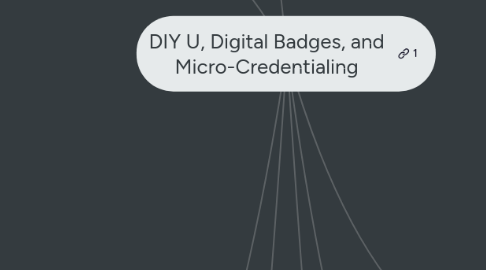
1. EXAMPLES
1.1. Alternative Traditional
1.1.1. InFed: Encyclopedia of Informal Education
1.1.2. Khan Academy
1.1.3. Pseudo-Universities
1.1.3.1. Floating University
1.1.3.2. Peer to Peer University
1.1.3.3. Ragged University
1.1.3.4. Saylor Foundation
1.1.4. Open Education
1.1.4.1. OER Commons
1.1.4.2. Open University
1.1.4.2.1. iTunes
1.1.4.3. Background: Creative Commons
1.1.5. Alternative assignments
1.1.5.1. Growing the List: 50 Digital Education Tools and Apps for Formative Assessment Success
1.1.5.2. Digital & Interactive media assignments
1.1.5.2.1. What are Digital Media Assignments?
1.1.5.2.2. How to design a digital media assignment
1.1.5.2.3. Digital Media Assignments
1.1.5.2.4. Resource Bank
1.1.5.2.5. Examples
1.1.6. MOOCs
1.1.6.1. Coursera
1.1.6.2. EdX
1.1.6.3. Hype cycle for education
1.2. Other types
1.2.1. Games/VW
1.2.1.1. CodeAcademy
1.2.1.2. Open University in Second Life
1.2.1.2.1. Flickr
1.2.1.2.2. Movie
1.2.2. Sharing learning
1.2.2.1. Brooklyn Brainery
1.2.2.2. Streetbank
1.2.2.3. Udacity
1.2.3. Selling learning
1.2.3.1. Udemy
1.2.3.2. WizIQ
1.2.4. Sharing skills
1.2.4.1. Bristol Skillswap
1.2.4.2. Brooklyn Skillshare
1.2.4.3. Skillshare
1.2.4.3.1. About
1.2.4.3.2. Skillshare: Learn
1.2.4.3.3. Skillshare: Teach
1.2.4.3.4. Penny Conference
1.2.5. Sharing/Selling tasks
1.2.5.1. TaskRabbit
1.2.5.2. Zaarly
1.3. MICHIGAN
1.3.1. Mblem
1.3.2. Open Michigan
1.3.3. Coursera
2. CHALLENGES
2.1. Concerns
2.1.1. Pricing ourselves out of the market
2.1.2. You can't just keep making class size better
2.1.3. Students don't want to sit in class
2.1.4. Will kids know how to be independent learners?
2.1.5. How to scale?
2.1.6. Haves vs havenots
2.1.7. PEDAGOGY
2.1.8. Assessment
2.1.8.1. Students sharing "answers
2.1.8.2. Are the teachers asking the right questions?
2.1.9. Analytics / "impact"
2.2. Questions
2.2.1. "Who offers a learning experience that is value added, different than the lecture hall?
2.2.2. Maybe the future of higher ed is to do what it does well even better"
2.2.3. Higher ed isn't formatted well for the "Bulge Learner"
2.2.4. How does this connect to Common Core in K12?
2.2.5. What aout fostering independent learning from an early age?
2.3. Takeaways
2.3.1. Administration vs Self-design
2.3.2. Face to face vs online community building
2.3.3. Less about the content
2.3.3.1. Define competencies
2.3.3.2. Assess / measure competencies
2.3.3.3. Demonstrate competencies
2.3.4. Digital divide
2.3.5. Goals
2.3.6. Economics
3. SUCCESS
3.1. Why succeed?
3.1.1. Social Support
3.1.2. Other motivation structures
3.2. What is success?
3.2.1. Identifying success
3.2.1.1. Online learning readiness self-assessment tool
3.2.1.2. Evaluating Online Learning (2008)
3.2.2. Measuring Success
3.2.3. Sharing Progress & Success
3.2.3.1. Badges
3.2.3.1.1. Open Badges
3.2.3.2. Credit transfer
3.2.3.2.1. Open University
3.2.3.3. Certificates
3.2.3.3.1. MOOCs from Great Universities
3.2.4. Showing Progress
3.3. Badges
3.3.1. Higher Ed Badging Projects
3.3.2. Issuing Platforms
3.3.3. Design Principles Project
3.3.4. Cities of Learning
4. FUTURE DIRECTIONS
4.1. Badges
4.1.1. IMS Global
4.2. LinkedIn and Lynda
5. INTRO
5.1. Patricia
5.1.1. CoolToys
5.1.2. Online Social Learning Spaces (mindmap)
5.1.3. Social Networking in Learning: Techniques & Tools
5.2. Steve
5.2.1. LED Lab
5.2.2. Badge Primer
6. TERMINOLOGY
6.1. Integrative learning
6.1.1. Engaged learning
6.2. Gamification
6.2.1. Gameful Design for education
6.3. Certification
6.3.1. Credential
6.3.2. Competency-Based Education
6.3.3. Badges
6.3.3.1. Micro-credentialling
6.3.3.2. Nano-credentialling
6.3.3.2.1. Udacity's Nano-degrees
6.3.3.3. Leveling up
6.3.3.3.1. "Stackable" badges
6.3.3.4. Digital Badges vs. Open Badges
6.3.3.5. Open badge anatomy
7. CONTEXT
7.1. Factors driving the DIY movement in education
7.1.1. Bubble
7.1.1.1. (Busted Prezi)
7.1.2. Access
7.1.3. Economics
7.1.4. Personalization
7.1.5. Special needs
7.1.5.1. Learning disabilities
7.1.5.2. Special topics
7.1.5.3. Special tasks
7.1.5.4. Short term goals
7.2. What does DIY mean in education?
7.2.1. College Rankings
7.2.1.1. Make Your Own College Rankings
7.2.1.2. DIY College Rankings
7.2.2. Do it Myself
7.2.2.1. DIY U
7.2.2.2. Do It Yourself Scholar
7.2.2.3. SOLE (Self-Organized Learning Environment)
7.2.2.3.1. About SOLE
7.2.2.3.2. Sugata Mitra
7.2.2.4. Uncollege
7.3. GOALS
7.3.1. Personal
7.3.1.1. Fill gaps
7.3.1.2. Catch up
7.3.1.3. Special needs, not a good fit in traditional classroom
7.3.1.4. Hobbies
7.3.2. Programmatic / Enterprise
7.3.2.1. Here’s What Will Truly Change Higher Education: Online Degrees That Are Seen as Official
7.3.2.2. New Arizona State-edX MOOC: Another blow to traditional college
7.3.2.3. Scenario: Recruiter
7.3.2.3.1. Resumes
7.3.2.3.2. How do I vet skills of DIY U spaces?
7.3.2.3.3. Train me how to evaluate these students?
7.3.2.3.4. Will nontraditional student be in my keep file?
7.3.2.4. Employability
7.3.2.4.1. If B.A.’s Can’t Lead Graduates to Jobs, Can Badges Do the Trick?
7.3.2.4.2. Resumes
7.3.2.5. Workplace Badging
7.3.2.5.1. Top 5 benefits of open badges for corporates (2013)
7.3.2.5.2. Reward Your Staff for Learning
7.3.2.5.3. Examples
